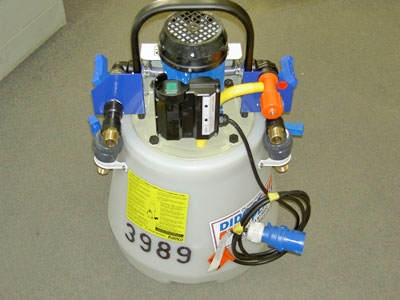What is a Powerflush?
What is a Powerflush?
So, we now know what the main reasons are as to why we need to get our system powerflushed. Exactly what is it?
Powerflushing is the removal of iron oxide sludge (dirty water in boiler and system) by means of a machine, connected to a central location. The two best places to connect the macine are where the central heating pump is fitted, or onto the feed pipes to the gas boiler. (Too many installers incorrectly connect the powerflushing machine onto a radiator fed by tiny pipe, for convenience because it's in the hall, or by the back door. Straight away, this reduces the effectiveness of the powerflush, as the flow through the machine is governed by the pipework sizing of the radiator). Chemicals are added to the system to loosen the debris in the system. This is normally done in day, or ideally at least a week before the flush is done. Any remedial pipework alterations are now also carried out before we do the powerflush.
Typical Powerflush Machine (without the hoses) |
Okay, so the machine is connected, now we isolate the feed tank in the loft and clean that by hand using soapy water. Onto the technical part, the powerflushing machine is going to push water around the radiators under high velocity, but low pressure (typically the same aount of pressure as your central heating pump), we need fresh cold water in, and we have a dump hose out, to get rid of the dirty water, so we need access to a foul drain. (If you have a no drains but a cesspit please check with your local authority regarding getting rid of the waste central heating water) So we are now blasting water round the system, just like a jet wash, and every now and again, we can reverse the flow on the machine backwards and forwards, to swish the dirt loose. It is also helpful if we can get the boiler to light whilst doing this, as the heat will give us a better resultant flush. If there are radiators with lots of cold spots, we may also use a soft rubber mallet to tap the bottom of the radiators, to help dislodge any stuck iron oxide that has clumped inside a radiator. If there are any problematic radiators, we can also isolate the other radiators and have the machine going around just those in question.
Finishing Off
After a while, the dirty water and chemicals will have been removed down the dump hose, and once it's all clear, we can pack away, install any system protection filters, and remember to add inhibitor at the correct dose! The inhibitor needs to go directly into the system, and not just sitting in the feed tank in the loft where it will go all crusty!
The final part will be to balance the system. Water will naturally go down the easiest path, so some radiators might not get hot. To overcome this, the hotter radiators can be adjusted up or down. We normally turn one of the valves down, called the lockshield valve, it normally has a smooth cap on it that you can't turn unless you remove the cap. The radiator will still get as hot, but with less water flowing through. Typically those upstairs get hotter first, as heat naturally rises, so we normally turn the ones upstairs down, and the one downstairs up!
Reap the Rewards
Once a powerflush has been done right, you can benefit from;
- hotter radiators meaning slightly lower gas bills
- not having to bleed radiators all the time
- less callouts due to components failing
- less noise from boiler and system having to work too hard
It is a long article, however I hope you now understand the importance of the poweflush for your central heating, and how the water in the system can cause so many problems if not correctly looked after.
As a footnote, if you have had a powerflush, or have decided to have one carried out, please make sure you get your inhibitor level checked every couple of years. For such a small cost, it can save a lot of problems further down the line!

